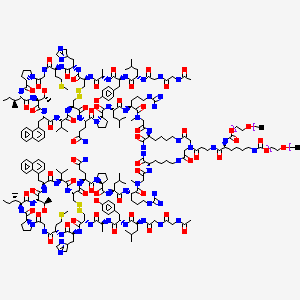Attribution Statement: LactMed is a registered trademark of the U.S. Department of Health and Human Services.
NCBI Bookshelf. A service of the National Library of Medicine, National Institutes of Health.
Drugs and Lactation Database (LactMed®) [Internet]. Bethesda (MD): National Institute of Child Health and Human Development; 2006-.
CASRN: 913976-27-9

Drug Levels and Effects
Summary of Use during Lactation
No information is available on the clinical use of peginesatide during breastfeeding. Because of its large molecular weight of 4900 daltons, excretion into breastmilk should be minimal and it would not be expected to be absorbed from breastmilk by the infant. Polyethylene glycol is not excreted into breastmilk.[1] However, until more data become available, an alternate drug may be preferred, especially while nursing a newborn or preterm infant.
Drug Levels
Maternal Levels. Relevant published information was not found as of the revision date.
Infant Levels. Relevant published information was not found as of the revision date.
Effects in Breastfed Infants
Relevant published information was not found as of the revision date.
Effects on Lactation and Breastmilk
Relevant published information was not found as of the revision date.
Alternate Drugs to Consider
References
- 1.
- Clowse ME, Förger F, Hwang C, et al. Minimal to no transfer of certolizumab pegol into breast milk: Results from CRADLE, a prospective, postmarketing, multicentre, pharmacokinetic study. Ann Rheum Dis. 2017;76:1890–6. [PMC free article: PMC5705850] [PubMed: 28814432]
Substance Identification
Substance Name
Peginesatide
CAS Registry Number
913976-27-9
Drug Class
Breast Feeding
Lactation
Colony-Stimulating Factors
Hematinics
Hematopoietic Cell Growth Factors
Disclaimer: Information presented in this database is not meant as a substitute for professional judgment. You should consult your healthcare provider for breastfeeding advice related to your particular situation. The U.S. government does not warrant or assume any liability or responsibility for the accuracy or completeness of the information on this Site.
- User and Medical Advice Disclaimer
- Drugs and Lactation Database (LactMed) - Record Format
- LactMed - Database Creation and Peer Review Process
- Fact Sheet. Drugs and Lactation Database (LactMed)
- Drugs and Lactation Database (LactMed) - Glossary
- LactMed Selected References
- Drugs and Lactation Database (LactMed) - About Dietary Supplements
- Breastfeeding Links
- PMCPubMed Central citations
- PubChem SubstanceRelated PubChem Substances
- PubMedLinks to PubMed
- Review Liraglutide.[Drugs and Lactation Database (...]Review Liraglutide.. Drugs and Lactation Database (LactMed®). 2006
- Review Pramlintide.[Drugs and Lactation Database (...]Review Pramlintide.. Drugs and Lactation Database (LactMed®). 2006
- Review Exenatide.[Drugs and Lactation Database (...]Review Exenatide.. Drugs and Lactation Database (LactMed®). 2006
- Review Enfuvirtide.[Drugs and Lactation Database (...]Review Enfuvirtide.. Drugs and Lactation Database (LactMed®). 2006
- Review Peginterferon Alfa.[Drugs and Lactation Database (...]Review Peginterferon Alfa.. Drugs and Lactation Database (LactMed®). 2006
- Peginesatide - Drugs and Lactation Database (LactMed®)Peginesatide - Drugs and Lactation Database (LactMed®)
Your browsing activity is empty.
Activity recording is turned off.
See more...
